
五代目 野田岩 銀座
Godaimenodaiwaginza
3.55
Ginza
「Unagi (Freshwater eel)」
8,000-9,999円
6,000-7,999円
Opening hours: 11:30-14:0017:00-20:00(L.O.)
Rest time: Sundays and holidays Business hours and holidays are subject to change, so please check with the store before visiting.
東京都中央区銀座4-2-15 塚本ビル B1F
Photos
(20)


















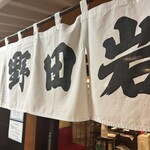

Details
Reservation Info
can be reserved
Children
child-friendly
Payment Method
Credit cards accepted
(JCB, AMEX, Diners, VISA)
Electronic money is not accepted.
Restaurant Service Fee
10% service charge
This fee is charged by the restaurant, not related to our platform
Number of Seats
32 seats
(32 seats at table)
Private Dining Rooms
None
Smoking and Non-Smoking
No smoking at the table
Parking
None
Facilities
Calm space
Drink
Sake and wine available
Dishes
Focus on fish dishes
Comments
(21)
蓼喰人
4.00
I had some business in Ginza before noon, so I decided to stop by this restaurant on my way back. Despite having various options within walking distance, I chose this one as it is directly connected to the subway, especially with the rainy weather. The main branch in Iidabashi is well-known as a prestigious eel restaurant in Tokyo, and this location has a similar reputation. The building, Tsukamoto Sannenzaka Building, is quite old and has been connected by an underground passage since the Marunouchi Line was laid over 60 years ago. There is also the famous Sukiyabashi Jiro located across from here, which I had visited once last year upon MF's invitation. Another popular restaurant, Birdland, is also on this floor and has earned one Michelin star. I arrived right at the opening time of 11:30 am, but there were already customers seated at the tables in the back. It seemed like there were also reservations for lunch gatherings at several tables. I was greeted by a female staff member in a kimono and was seated at a table in the corner. The menu displayed also mentioned that they had natural eel available today, and for an additional 600 yen, it could be added to the eel bowl. The menu included five types of eel bowls as well as a variety of courses to enjoy. I found the "Chidori" option intriguing, and since it could be upgraded to natural eel for an extra 600 yen, I decided to go for it. I wanted to have a drink, so I chose the Iwate local beer "Sansho Ale," which is flavored with Japanese pepper, and it had a subtle hint of the spice, which was quite enjoyable. The "Chidori" course included the following: The appetizer consisted of "eel on ice" and "simmered eel," both served in small portions but with excellent craftsmanship, especially the texture and flavor of the eel on ice was outstanding. The "one-bite grilled eel" was elegantly presented in a metal box with a square lacquered piece placed on top, a special container traditionally used in old Edo-style eel restaurants for keeping it warm. When I opened the lid, a relatively large quarter of a white-grilled eel appeared. It was accompanied by wasabi, salt, and soy sauce, and the taste was indeed delicious, perhaps due to it being natural eel. The "eel bowl" was served in an elegant Arita ware bowl, and upon lifting the lid, a generous portion of half a grilled eel was delicately arranged on a bed of rice. The eel had a minimal char and glaze, showcasing the restaurant's subtle style. The wide-mouthed bowl allowed for a beautiful presentation, and the quality of the rice and evenly distributed sauce made it a delightful dish. When I dug in with my chopsticks, the eel and rice melded seamlessly, a characteristic of the steamed process in traditional Edo-style eel cuisine. The eel, with just the right amount of fat removed, had a refined taste, and the sauce, not too strong and with a hint of sweetness, was sophisticated. The rice was of excellent quality, and the pre-applied sauce evenly coated it, enhancing the overall experience. The "eel liver" was well-prepared and generously portioned with mitsuba garnish, and the liver had a perfect texture for sipping. The "grated radish" served as a palate cleanser, although I felt the pickles were unnecessary. The "pickles" included "daikon and cucumber nukazuke and cabbage asazuke," and while I missed the traditional Narazuke, it seems that some restaurants have stopped serving it recently, possibly due to the alcohol content. For dessert, I was served "plum wine jelly," which had a pronounced plum wine flavor and a pleasing texture reminiscent of agar used in pastries, a delightful finish to the meal. Although each portion was small, the variety of dishes showcased the restaurant's full range of offerings. The basic course was priced at 5,300 yen, with an additional 600 yen for natural eel, plus the drink and a 10% service charge, bringing the total to 7,500 yen. The taste, as well as the functional beauty of the presentation, left a lasting impression.


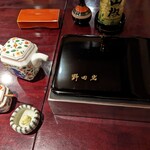

hirom389
3.90
It was hot, so I felt like eating eel and decided to visit this restaurant. I arrived around 12 o'clock and had to wait for about 15 minutes as there were two groups ahead of me. Today's eel was a bit more expensive, about 600 yen more due to being natural. I ordered an eel rice bowl, which cost 5,500 yen as shown in the picture. The eel was steamed and tender, very delicious, similar to the eel in the Kanto region.

食べ六
3.50
I went close to the Midsummer Day of the Ox, so the eel was only natural and 1,000 yen more expensive. The grilled eel and eel liver were delicious, but I felt like the farmed eel had more fat and was fluffier. Maybe because I'm not used to it? Well, next time I'll go with the farmed eel. I arrived 10 minutes before the opening, but the line was short, and I was able to enter as soon as they opened.


DJKumaKuma
3.70
Noda Iwa is a renowned eel restaurant in Tokyo, currently run by the 5th generation, and the branch in Ginza is a directly managed store. Every year, they are closed on Saturdays designated as Ushi no Hi, showing their prestige as a top-tier establishment. The staff wear traditional kimono attire, and they serve green tea initially and hojicha after the meal. Today, they served wild eel from Ibaraki Prefecture, which seemed less impressive compared to farmed eel. The sauce at Noda Iwa is not too strong, allowing you to enjoy the natural flavor of the eel. However, this year, it felt like something was lacking in flavor. It may not be the best choice for those looking for a hearty meal. I am satisfied with receiving the traditional fan, which I have been getting for the past seven years.




uchico_n
4.00
On a Saturday night when I wanted to eat eel, I searched for a restaurant near Yurakucho with a friend and ended up here. Upon entering, we were greeted by the polite service of the staff dressed in kimonos and were seated. We started with a bottle of Sapporo beer for a toast. We also ordered a platter of three appetizers (eel simmered in soy sauce, edamame, and pickled vegetables) and smoked eel in vinegar (I think that's what it was). We then enjoyed the grilled eel dish and topped it off with an eel rice bowl. I also had a Yamanashi spicy beer while savoring this blissful moment. The grilled eel was delicious, but the simmered eel and smoked eel were also very tasty! As we left, they kindly gave us a paper fan and heatstroke prevention candy, saying "It's hot, so please take care." This thoughtful gesture added to the delightful hospitality and made our hearts feel light.
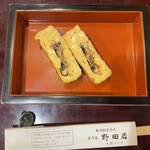



おやじ食道
2.90
This restaurant was at the top of my list of famous eel restaurants that I had been wanting to visit for a while. I made a reservation for 5:00 pm and when I arrived, the restaurant was empty. I ordered the 11,500 yen course, but was told that they only had wild eel today, which cost an additional 2,500 yen. The eel in front of the restaurant was labeled as "wild eel available," but it turns out there was no choice in the matter. The service was slow-paced, reminiscent of an old-fashioned traditional restaurant, but lacked a sense of genuine hospitality. The eel served was thin and lacked the charred aroma from grilling. The first dish, white grilled eel, was small with little fat and tasted too light, almost like a regular conger eel. The steamed egg custard with shark fin was thin and lacked the usual smooth texture. The grilled eel that followed was small, with a subtle sauce and a mild taste that didn't quite hit the mark. I also ordered a glass of red wine, but it was too acidic and didn't pair well with the eel. The eel was said to be from Ibaraki, but the wild eel's appearance was unimpressive and the taste was too light and protein-rich. Personally, I think farmed eel tastes better. I think I'll stick to the eel I can get through the Wakayama hometown tax or at chain restaurants like Unatoto. My friend treated me this time, so I was lucky, but I probably won't go back on my own.




Don葉桜
3.60
The 5th generation Nodaiwa at Ginza Nodaiwa is said to be directly related to the Azabu Asakura main store. Located in the basement of Tsukamoto Soyama Building in Ginza 4-chome, right next to Sukiyabashi Jiro. The Tsukamoto Soyama Building, completed in 1960, is a building named after the founder of Tsukamoto Sogo, with a tremendous history. It's no wonder that a renowned restaurant is located in such a place. On this day, we ordered the eel set course, starting with a non-alcoholic sparkling drink and appetizers. The grilled eel in a steamed box was served lightly seasoned with wasabi, salt, or soy sauce, showcasing the delicate texture of the eel. The eel and shark fin chawanmushi allowed us to enjoy the aroma of the eel and the texture of the shark fin together. The eel set was served with a Kanto-style steamed dish to remove excess fat, resulting in a light and fluffy texture. While the sauce was not overpowering, it may have been better if it had a stronger flavor to distinguish it from the grilled eel. I still have a lot to learn to appreciate the taste of a longstanding prestigious restaurant. We made a reservation and although there were some empty seats, it allowed us to enjoy our meal in a calm atmosphere. The attentive service of the meticulous staff added to the overall tranquility. Truly a venerable establishment that has been operating in Ginza for a long time. Thank you for the meal.




サイモン64
4.30
Whenever I mention Nodaiwa, I usually go to the special dining area at Nihonbashi Takashimaya, where I don't have to go through the hassle of making a reservation. However, I decided to try the Ginza branch for a change. The seating was relatively spacious and comfortable, unlike the slightly cramped feeling of the main branch. The staff were attentive and the atmosphere was pleasant. Unlike the special dining area at Takashimaya, there were no restrictions on taking photos here, which was nice. I started with the Umaki for 620 yen, a bottle of beer for 780 yen, and the Shirayaki for 3500 yen. We then opened a bottle of Chablis for 6000 yen and finished with the Nakaire Don for 4100 yen. The grilled eel was delicious as always, although the sauce seemed a bit sweet. I think next time I come to Nodaiwa, I'll choose the Ginza branch. Check out my video on YouTube at https://youtu.be/35329VGVMTY



がゆう
0.00
I went shopping in Ginza and decided to visit Nodaiwa for some eel since I was there. I didn't have a reservation and went alone. I had to wait a bit, but was seated promptly. I ordered a bottle of beer and the Hanabishio sake. They asked if I wanted some appetizers to go with my beer, so I agreed. The simmered dish had a great eel flavor and was very tasty. The smoked eel was amazing as a snack! I liked it so much that I wanted to order it separately to go with my drinks, but decided not to since there were other customers waiting. The eel bowl arrived fairly quickly. The eel was soft and tender, with a soy-based sauce that paired perfectly. I really want to come back to enjoy the smoked eel with some sake next time. It was a wonderful afternoon in Ginza. I will definitely visit again!




えりころたん
3.70
I was hooked on the fluffy eel at Noda Iwa, which had high ratings and had caught my attention. It's conveniently located directly connected to Ginza Station! This time, I had the eel rice course. The appetizer was eel jelly and rapeseed blossoms with boiled eel and shark fin chawanmushi (eel liver, pickles, palate cleanser). For dessert, it was a course featuring eel with strawberries. The grilled eel was tender and fluffy! The shark fin in the chawanmushi had a slight glass noodle texture, and I wondered if it was necessary. As for the eel rice, the eel was steamed and baked to perfection, with the oil properly drained, resulting in a moist and tender texture that was delicious. The balance between the sauce and rice was exquisite. At first glance, the sauce seemed thin and the grilled marks were light, but the sauce was not too sweet and added a refreshing touch to the rice, making it hard to stop eating. Even after a full course meal, I felt like I could eat more of this eel rice. The dessert with strawberries provided a refreshing end to the meal. The staff were all elegantly dressed in kimonos, exuding the grace of a long-established restaurant. The traditional Edo-style eel truly lived up to its reputation.



kota19940915
4.50
I was taken to this restaurant by a senior executive at the company. My expectations were already high, but the food was delicious and the atmosphere of the restaurant was calm and pleasant. The eel was tender, the sauce was sweet and savory, and I thought it was a taste that would appeal to everyone, matching its price.

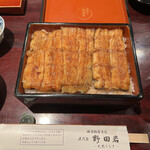
あるぱかーん
3.80
It's been about 10 years since I last visited Nodaiwa in Ginza, a prime location. This is my first time writing a review. It is located on the basement floor of a building, right in front of Sukibayashi Jiro. The Ginza branch is a branch of the Azabu Asakura main store. The branches are located in Ginza, Nihonbashi Takashimaya, Shimo-Kitazawa, and Paris, with only these four stores. The rest are all offshoots. I have visited all of them, but the Ginza branch has a similar atmosphere to the main store, with red sofas and all. I ordered the smallest size of eel rice due to some circumstances. The differences in the eel rice are as follows: Kiku 0.5 tail, Ume 3/4 tail, Hagi 1 tail, Yamabuki 1 tail, Katsura 1.5 tail. Hagi and Yamabuki are differences in weight. Today's eel is said to be from Shizuoka Prefecture. It is steamed and charcoal-grilled. ▶︎ Ordered items ・ Eel rice Kiku 3190 yen Pickles, liver sucking, chopstick rest Service charge 10% included Nodaiwa is steamed in advance, so it arrived in about 9 minutes. I am not surprised by the speed as usual. The eel looks so beautiful~ I haven't been to the direct descendant Nodaiwa for a long time, but I still feel the original atmosphere the most. When it comes to Nodaiwa, it's all about this visual. The size is 5P. You can tell just by touching it that it has been steamed quite strongly and grilled. It's such a meticulous job with no burnt spots. When I tried it... hmm, it's delicious. I went to Nodaiwa in Omori the other day, but this one tastes more like the original and is really delicious. The texture is fluffy and flaky, not dry at all, with a unique mouthfeel. Although the fat is reduced and it feels refreshing, the taste seeps out gently from the inside. It's really Nodaiwa's unique grilling. No matter how many times I eat it, it always tastes delicious haha. The skin is grilled with a moderate char, giving a nice toasty flavor when you chew. While trimming off excess, it brings out the taste of the eel as a fish. The eel's own aroma was also clearly felt. The freshness doesn't seem too bad either. It's amazing how it's pre-steamed and still fresh haha. The sauce is also delicious. It's a classic Edo-style sauce made with soy sauce and mirin only. After the initial sweetness of mirin, the soy sauce comes in smoothly and ties it all together nicely. The balance of acidity and sweetness is good, and the saltiness is mild. It's refreshing and very elegant sauce. It's generously coated with sauce, but it's not at all overpowering and enhances the taste of the eel. The combination of charcoal and sauce creates an excellent flavor. The sauce is definitely better in the direct descent. The grilling is also meticulous and well done. The rice is also very delicious. It has a good graininess and rich flavor. The balance of the sauce is excellent too. The pickles and liver sucking are also great. The liver was in a part I didn't quite understand, but it was delicious with a nice toasty flavor. The grated daikon for chopstick rest is a great supporting player. Since the eel's taste is quite strong, having this grated daikon or not makes a big difference. The sansho pepper is also incredibly delicious. It was my first time in a long time at the Ginza branch, but it was so delicious haha. Direct descendants are different indeed, just like Jiro. They are much tastier than the offshoots. It's a shame that there is a service charge, but considering it as part of the price, the taste was justified. I will visit the main store again after a long time~ Thank you for the meal~!




Shinnosuke3023
3.50
I visited Nodaiwa for the first time in a while and chose the eel rice course for lunch. The course included appetizer, simmered dish, grilled eel, steamed egg custard with shark fin, eel rice bowl, and dessert. The grilled eel was surprisingly light and tender as it was steamed well to remove excess fat. The eel rice bowl had a soy sauce aroma but a smooth and elegant taste.



じょいと
3.50
I accompanied my friend to a restaurant they wanted to go to. We arrived around 5pm on a weekday, a time when most people are still at work. Feeling slightly hungry, we decided to check out the place. We ordered an eel and shark fin steamed rice bowl (small) for ¥820. It was the first time I had seen a combination of eel and shark fin, and it was delicious with a refined broth. It served as a nice appetizer. For the main dish, I chose the eel rice bowl with plum for ¥3500. There were 6 different options based on the amount of eel, and I chose the one with one and a half pieces of eel. It came with pickles, grated radish, and eel liver. The eel had a light brown color and a mild sauce, which made it easy to eat. The rice was not overly sauced, but it would have been nice to have a sauce bottle on the table for those who want more. The eel was tender and boneless, making it easy for elderly people to eat. The portion size was just right, and I was able to finish it comfortably. We enjoyed our meal without feeling rushed, which was a pleasant experience.

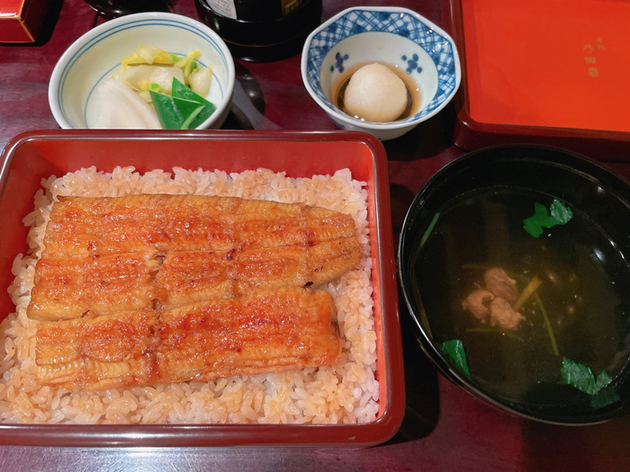
電球
3.90
I made a reservation for the opening hours and visited the restaurant. I had been craving eel for a while and finally found this place. The dishes were prepared with great attention to detail, taking into account the table situation. Although they had natural eel available that day, I decided not to order it. The simmered eel was delicious! I also ordered caviar and tried it on top of the "shirayaki" eel. The saltiness complemented the dish well. There was a wide selection of wines, which seemed to be popular to pair with the food. In the end, we were full from sharing a set meal. The eel was cooked just right, with a tender texture. The grilling method differed between Kanto-style and Kansai-style, and personally, I prefer the crispy Kansai-style. However, the eel here was unique in that the skin was easy to cut through and had no distinct taste. I noticed that the sauce had a stronger salty flavor and less sweetness compared to others. I also tried the sansho pepper beer, which had a subtle hint of pepper aroma. It paired perfectly with the shark fin chawanmushi. Thank you for the wonderful meal! I will definitely visit again!




へっぽこ大王
4.60
This month, I held a personal food tour in Tokyo and yesterday I hit the mark with the 10th race at Heiwajima Boat Race, winning a jackpot of 12,850 yen and making a profit of about 9,500 yen. For lunch on the second day of my stay, I decided to change my plans and went to the famous eel restaurant, Godai Noda Iwa Ginza Store in Ginza. I ordered a small bottle of beer (560 yen) and an eel rice box set (kiku) with liver, pickles, and a palate cleanser for 2,900 yen. The small bottle of beer arrived first. It was a hot day in Tokyo, and the ice-cold Sapporo Black Label tasted great! After about 15 minutes, the eel rice box set (kiku) with liver, pickles, and a palate cleanser arrived. When I opened the lid of the box, the savory smell of the grilled eel made my mouth water. I sprinkled some sansho pepper on top and savored each bite. The eel was carefully grilled to perfection, with a hint of steaming unique to the Kanto region, making it soft and flavorful. The freshly cooked rice had just the right texture and absorbed the eel sauce beautifully, creating a delightful combination. The liver was mild in flavor but complemented the eel rice box well. The pickles, consisting of cabbage, cucumber, and radish, served as a refreshing palate cleanser. The grated radish was a nice touch and helped balance out the rich flavors of the eel. I finished my meal with a warm hojicha tea and savored the lingering taste. It's no surprise that this restaurant is rated highly on Tabelog. The attentive and excellent service provided by the staff added to the overall dining experience. The total bill came to 3,800 yen. Thank you for the wonderful meal.
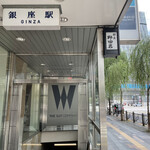



にゃーこ0707
3.40
The eel was steamed and very tender and delicious, but the staff was few and it was difficult to get orders promptly. When I asked about the payment method, I was told that I could pay at the register if I wanted a table check, which was a bit disappointing. I ordered the eel with sansho pepper.

DJKumaKuma
3.70
On July 23rd, which falls on a Saturday Ushi no Hi (Ox Day), I visited Noda Iwa in advance as they are closed on Ushi no Hi. On this day, they had received fresh eel, and I paid a little extra to upgrade to the natural one. The staff members were dressed in kimonos and looked cool. This restaurant charges a service fee. They also serve hojicha and green tea. The service is top-notch, as expected from the long-standing Noda Iwa. The eel was refined, and the sauce was not too heavy, which I believe is a characteristic of Noda Iwa. Every year on Ushi no Hi, they give out folding fans, which has become something I look forward to each year. It was delicious! Thank you for the meal! I feel like I can survive this hot summer!
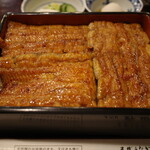



とんぼ ととろ
3.70
We chose to go to Nodaiwa in Ginza with our family instead of the Iinariya restaurant. The atmosphere may not be as nice as the Iinariya restaurant, but the accessibility made us choose Nodaiwa this time. The eel dish at Nodaiwa is exquisite with a delicate and elegant sauce. The grilled eel and simmered eel liver were both incredibly delicious.



カレ犬
4.00
For people in Tokyo, the difference between unadon and unaju seems to be just whether the container is round or square. When you go to a slightly fancy eel restaurant in Kansai, unaju is where eel is stacked on top of the traditional eel box, so you get layers of eel, rice, eel, rice, eel. So when you eat eel in Tokyo, most of the time you feel somewhat unsatisfied, like you've been deceived (although there are occasionally double layers). However, people in Tokyo seem to regard eel as something special, with many eel restaurants having a somewhat high-class appearance. The question arises whether it's really worth considering eel so special. Well, since I haven't been to a proper eel restaurant in Tokyo, I decided to visit "Noda Iwa" to find out. There were staff waiting at the entrance of the restaurant, providing a high-class service. The Ginza branch is located in the basement of a building, but once you enter the restaurant, it is designed with a traditional Japanese restaurant atmosphere, which is nice. The tables are large, but the seating is a bit tight. Freshly brewed tea is served, along with some appetizers to enjoy while waiting, and after about 20 minutes, the unaju arrives. In conclusion, it was simply rice in a square box (not even a tiered box), with the eel placed on top in a single layer. The taste was on the light side. However, eel flavor is eel flavor and sauce flavor, so it doesn't vary much. It was a fluffy Tokyo-style eel. The sansho pepper on the table didn't lose its fragrance. Additionally, the liver soup that came with it was the most delicious I've had. After finishing the meal, hot tea is served again. The service is really good. However, even if you order the most expensive unaju, the portion is still the same. When I ordered the most expensive unaju in Kansai, I felt so full that I couldn't move for a while, so the question mark about Tokyo's eel remains...


美食家 K
3.10
Eel specialty restaurant "Noda Iwa" is now in its 5th generation, established around the Kansei era from 1789 to 1801, with over 200 years of history as one of the top eel restaurants in Edo. The eel sauce at Noda Iwa is a lightly sweet and refreshing type. The eel is incredibly tender, easily cut with chopsticks, and plump, making it easy to eat. However, some may find it lacking in substantial flavor. The taste is not very strong.・Shop Name: 5th Generation Noda Iwa Ginza・Google Maps: Noda Iwa Ginza Store 03-5524-3125 https://goo.gl/maps/Ger86amQbGP15ig5A・Nearest Station: Directly connected to Exit C6 of Ginza Station. Entrance is on the stairs. 82m from Ginza Station.・Business Hours: 11:30-14:00, 17:00-20:00 (Last Order)・Regular Holiday: Sundays, Holidays・Reservation: Available・Number of Seats: 32 seats (all table seats)・Budget: Dinner 8000-9999, Lunch 5000-5999・Other Information: No private rooms, all seats non-smoking, no parking#GinzaEel #GinzaGourmet #GinzaLunch #GinzaUnagi #GinzaDinner #Unagi #Eel #GourmetLovers #GourmetInstagram #GurumeMemo #GourmetLoversWanted #FoodPornGram #FoodPornographer #TabeLog #TabeLogGram #FoodPornism #GourmetTravel #DeliciousIsHappiness #GourmetFriendsWanted #FoodieClub #FoodieGirls #FoodieGuys #WantToConnectWithGourmets #KantoGourmet #FoodReviewGram #GourmetReport #GourmetWriter #FoodWriter #BGradeGourmetInformation #TokyoGourmet




Email Login